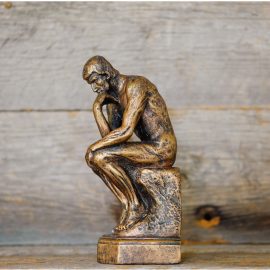

This article is an excerpt from the Shortform book guide to "The Gifts of Imperfection" by Brené Brown. Shortform has the world's best summaries and analyses of books you should be reading.
Like this article? Sign up for a free trial here .
What are the gifts of imperfection from Brené Brown’s book? How can the three gifts help you cultivate worthiness?
The three gifts of imperfection, according to Brené Brown, are courage, compassion, and connection. Together, these three gifts will help you live a Wholehearted life filled with happiness and self-acceptance.
Continue reading to learn about the three gifts of imperfection.
Cultivating Worthiness
So, we’ve learned what worthiness is, according to Brown The next question is, how can we cultivate worthiness? Brown’s research suggests that there are three values that you need to practice to increase your sense of worthiness: courage, compassion, and connection.
Here are descriptions of what each of the gifts of imperfection are:
Courage
By courage, Brown doesn’t mean the kind of courage you use during an act of heroism, such as the courage you show when you run into a burning building to save a child. Instead, she means ordinary courage—being brave enough to be vulnerable and honestly express who you are, how you feel, and what you’ve experienced. For example, it’s having the courage to admit to your boss that you’re struggling with your workload and need help.
| Ordinary Courage in Women and Girls In the footnotes of The Gifts of Imperfection, Brown states that she first encountered the term “ordinary courage” in the work of clinical psychology professor Annie Rogers. Where Brown talks about people in general needing to have ordinary courage, Rogers’s work specifically discussed ordinary courage in women and girls. In a research paper, Rogers noted that young girls often possess and use great ordinary courage, frequently speaking their minds and sharing their vulnerabilities. However, beginning in early adolescence, women stop using ordinary courage, becoming reticent to share the full truth of what they’re thinking and feeling. According to Rogers, this reduction in ordinary courage coincides with a loss of female confidence and resilience. Furthermore, the reduction in courage is probably the result of cultural norms that discourage women from speaking their minds. So, how can we encourage girls to continue to use ordinary courage, even as they enter adolescence? Rogers found that in her experience, role modeling—being courageous and vulnerable herself—encouraged girls to open up and be courageous in turn. Furthermore, research suggests that participation in adventure-based programs—outdoor retreats that often involve completing challenging physical and mental tasks in a group-based setting—can encourage courage in adolescent girls. |
Compassion
Brown calls practicing compassion an exercise in bravery, vulnerability, and acceptance. Put more simply, see compassion as being kind to yourself and others.
As well as explaining what compassion is, Brown clearly defines what it isn’t. It’s not condemning the person (or thing) that caused your, or another person’s, pain. Likewise, it’s not trying to erase the pain by seeking a resolution to that cause. Instead, it’s merely allowing yourself, or another person, to feel their feelings and express their pain. It’s about empathizing with the person who needs compassion (whether that’s you or someone else), not trying to “fix” them or their issues.
For example: If a friend confesses that her manager is belittling her at work, don’t jump to finding a fix for the issue, like suggesting she speak to human resources. Likewise, don’t rush to blame your friend or her manager for causing the issue. Instead, listen deeply to how your friend is feeling. Express empathy based on similar experiences you’ve had.
| Empathy and Nonviolent Communication Brown’s ideas on true compassion involving empathetic listening are backed up by Marshall Rosenberg in his work Nonviolent Communication. Rosenberg argues that many of us fall into one of the traps Brown described: trying to analyze and solve people’s pain, rather than just listening to and empathizing with it. In Rosenberg’s view, we commonly make this mistake because empathizing with others is hard and can be emotionally draining. So, we take the easier option of entering “fix-it” mode. However, to help others and maintain strong relationships, we must learn to simply listen to people, as difficult as that may be at first. |
Connection
Brown presents a definition of connection that’s personal rather than objective. To her, it’s an intangible energy generated when we form an open, judgment-free, and mutually sustaining bond with another person. More simply, understand connection as building meaningful and fulfilling relationships with others.
Citing the work of psychologist Daniel Goleman—specifically, his book Social Intelligence: The New Science of Human Relationships—Brown asserts that, at the most fundamental, biological level, humans need to develop strong relationships with others. She suggests that we can strengthen our connections by reaching out to other people regularly. We should also work to connect with them on more than a superficial level: We should share our honest thoughts and feelings with others and encourage them to do the same.
| Connection and Social Media You might think that social media sites are great places to connect with other people. However, according to Brown, while these platforms provide a convenient way of contacting people, they’re not the place to form real and deep connections. Various other writers and researchers back this view. For instance, in his book Lost Connections—about the social and societal factors that can contribute to depression—journalist Johann Hari also asserts that social media communication doesn’t provide the same benefits as in-person connection. Furthermore, Cal Newport argues in his book Digital Minimalism that replacing in-person communication with digital communication can actually erode our social skills. |
| How to See Our Own Worthiness Brown seems to be unique in explicitly connecting the cultivation of worthiness to practicing courage, compassion, and connection. Other writers have differing ideas on how we can learn to see our own worth: In 12 Rules for Life, Jordan Peterson claims that the solution to low self-worth is to remember that you have a unique mission to pursue and to recognize that you’re just as worthy of care and help as anyone else. In The Happiness Hypothesis, Jonathan Haidt ties feeling self-worth to having a purpose and feeling like you’re part of a greater mission.In Awaken the Giant Within, Tony Robbins argues that feeling in control of your life is essential to cultivating high self-esteem. If this diversity of opinion shows anything, it’s that self-worth is complex, with many factors feeding into or inhibiting it. |

———End of Preview———
Like what you just read? Read the rest of the world's best book summary and analysis of Brené Brown's "The Gifts of Imperfection" at Shortform .
Here's what you'll find in our full The Gifts of Imperfection summary :
- How to stop feeling like you're not "good enough"
- How shame affects your self-worth
- The 10 guideposts to living Wholeheartedly and cultivating worthiness






